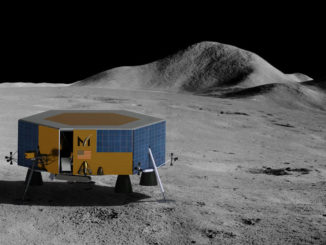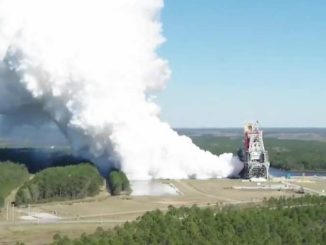
Mars rovers go through seven minutes of terror when they plunge into the Martian atmosphere at hypersonic speed. NASA’s OSIRIS-REx spacecraft will take a more glacial approach to its asteroid target Tuesday, and the event will be more akin to four-and-a-half hours of mild anxiety for ground teams, according to the mission’s operations manager.
The robotic explorer is set to snag a sample from asteroid Bennu, a clump of rock stretching a third of a mile (500 meters) wide located 207 million miles (334 million kilometers) from Earth. OSIRIS-REx will return the specimens to Earth in 2023 for detailed analysis in terrestrial laboratories.
The spacecraft will perform all its maneuvers Tuesday autonomously, navigating its way around Bennu’s weak gravity field using on-board algorithms that track landmarks on the asteroid and compare them to pre-loaded maps.
Read our comprehensive preview story for more details on the mission. Here is a list of the major events during the touch and go maneuver.
- 1:50 p.m. EDT (1750 GMT): OSIRIS-REx fires thrusters to leave a “safe-home orbit” roughly 0.6 miles (1 kilometer) from asteroid Bennu. The burn will change the craft’s velocity relative to the asteroid by less than 0.2 mph, or about 8 centimeters per second.
- 2:10 p.m. EDT (1810 GMT): OSIRIS-REx extends its robotic sampling arm — called the Touch And Go Sample Acquisition Mechanism, or TAGSAM. The arm is about 11 feet (3.35 meters) long, with a drum-shaped fixture on the end that resembles an air filter affixed to an antique automobile.
- 5:29 p.m. EDT (2129 GMT): OSIRIS-REx turns to the attitude, or orientation, for the final descent to the asteroid.
- 5:36 p.m. EDT (2136 GMT): OSIRIS-REx begins adjusting its two solar array wings to a “Y-wing” configuration to safely position them away from the asteroid’s surface.
- 5:50 p.m. EDT (2150 GMT): OSIRIS-REx performs a checkpoint burn to allow the spacecraft to begin a free fall toward the asteroid.
- 6:00 p.m. EDT (2200 GMT): OSIRIS-REx performs a matchpoint burn about 50 meters (164 feet) from the asteroid to slow its descent to a speed of about 0.2 mph (10 centimeters per second).
- 6:11 p.m. EDT (2211 GMT): OSIRIS-REx’s natural feature tracking navigation system autonomously determines whether the spacecraft is heading to a safe area for the sampling attempt. If not, this is the last chance for the spacecraft to command an abort and back away.
- 6:12 p.m. EDT (2212 GMT): OSIRIS-REx’s TAGSAM contacts the asteroid and discharges a bottle of compressed nitrogen gas to scour up bits of dust and rock up to 8 inches (20 centimeters) beneath Bennu’s surface. After 10 to 15 seconds, the spacecraft will fire thrusters to begin ascending from the asteroid.
During the most critical phases of the descent, the spacecraft will only send limited telemetry data back to Earth. Later Tuesday night, OSIRIS-REx will reestablish high data rate communications with ground teams, and controllers will be able to fully assess how the spacecraft performed.
The first images from the touch and go will be beamed back to Earth on Wednesday to show how the sampling system worked, and giving an early indication of whether the spacecraft gathered the expected specimens.
On Saturday, controllers are scheduled to command OSIRIS-REx into a spin maneuver to measure its moment of inertia. Engineers will compare the results to a similar maneuver before the sampling run, yielding an estimate of how much mass the spacecraft grabbed from Bennu.
“The requirement is 60 grams,” said Dante Lauretta, the mission’s principal investigator from the University of Arizona. “That’s based on the science team, where we’ve looked at all the laboratories across the world that we want to send material to, and how much material do we need to get the information about the organic chemistry, the hydrated minerals, the ages, exposures, all kinds of information about the sample. So the science needs the 60 grams.
“But TAGSAM actually was tested to pick up at least 150 grams (one-third of a pound),” Lauretta said. “And in the best case scenario where the TAGSAM filter is filled up … we might have a kilogram of sample or more.”
“The best outcome would be that we would collect a massive sample,” said Heather Enos, OSIRIS-REx’s deputy principal investigator at the University of Arizona. “We say we have a requirement for 60 grams, or 2 ounces, but we have the capability of collecting up to 2 kilograms. I would love for that capsule to be completely full.”
If NASA is satisfied with the amount of material picked up by OSIRIS-REx, agency leaders could decide Oct. 30 that the mission has met its sample collection requirement. In that case, the spacecraft will continue remote sensing observations of the asteroid before beginning its return to Earth in mid-2021.
Email the author.
Follow Stephen Clark on Twitter: @StephenClark1.



